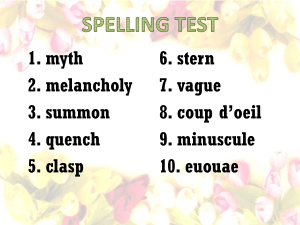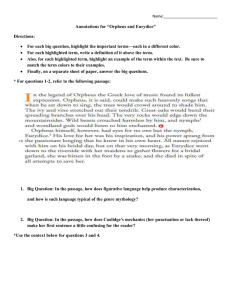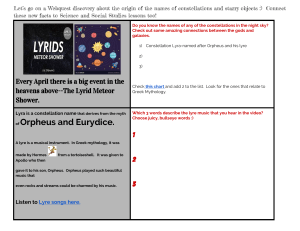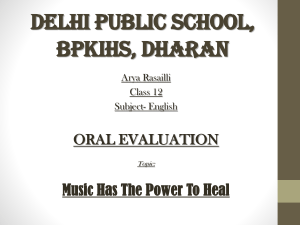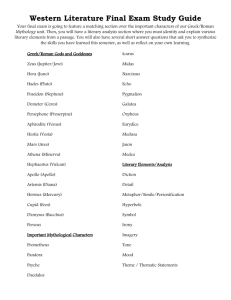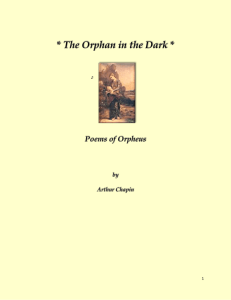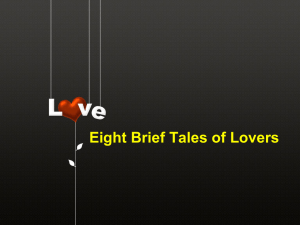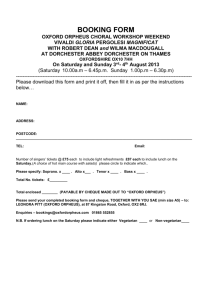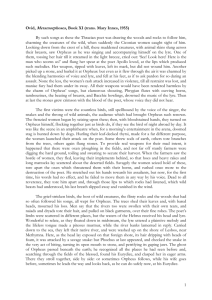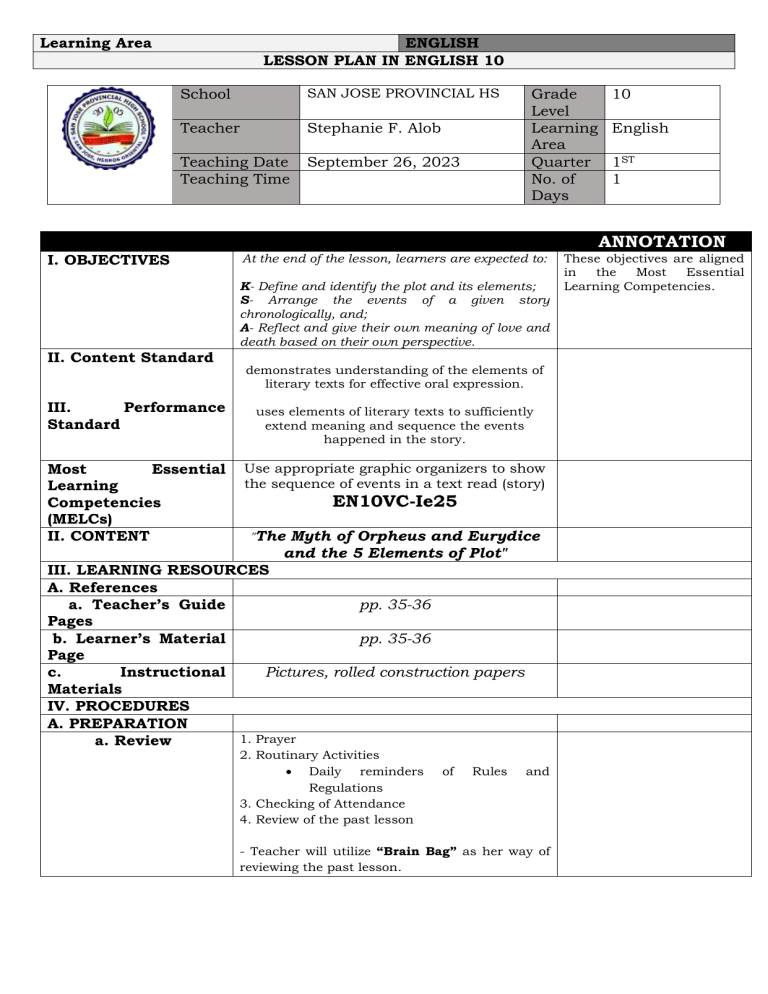
Learning Area ENGLISH LESSON PLAN IN ENGLISH 10 School SAN JOSE PROVINCIAL HS Teacher Stephanie F. Alob Teaching Date Teaching Time September 26, 2023 Grade Level Learning Area Quarter No. of Days 10 English 1ST 1 ANNOTATION I. OBJECTIVES At the end of the lesson, learners are expected to: K- Define and identify the plot and its elements; S- Arrange the events of a given story chronologically, and; A- Reflect and give their own meaning of love and death based on their own perspective. II. Content Standard demonstrates understanding of the elements of literary texts for effective oral expression. III. Performance Standard uses elements of literary texts to sufficiently extend meaning and sequence the events happened in the story. Most Essential Learning Competencies (MELCs) II. CONTENT Use appropriate graphic organizers to show the sequence of events in a text read (story) EN10VC-Ie25 "The Myth of Orpheus and Eurydice and the 5 Elements of Plot" III. LEARNING RESOURCES A. References a. Teacher’s Guide pp. 35-36 Pages b. Learner’s Material pp. 35-36 Page c. Instructional Pictures, rolled construction papers Materials IV. PROCEDURES A. PREPARATION 1. Prayer a. Review 2. Routinary Activities Daily reminders Regulations 3. Checking of Attendance 4. Review of the past lesson of Rules and - Teacher will utilize “Brain Bag” as her way of reviewing the past lesson. These objectives are aligned in the Most Essential Learning Competencies. - Learners will have to write a brain dump about all of the pieces of information they remember from the unit. - From the brain dump they write at least one question on an index card with the answer on the back. - Students need to write their name on the index card, too. We place all of the questions in a brown paper sack. This is our class “brain bag” with a bunch of facts we know. - The person who wrote the question asks the whole class. Each team records their answer on a small whiteboard, shows their whiteboard to me, and can earn a point for a correct response. b. Motivation "Don't look back Game!" Four members of the group will make a reallife painting to picture out the word that I will attach on the back of one of the other members who will guess the mystery word. The four members only have 30 seconds to make the real-life painting. After that, the audience will say. "Don't look back" and another 30 seconds will be given to the guesser to guess the word. No one is allowed to talk except the guesser until he gets the answer. You have to say "farewell" when the guesser gets the answer. Words that need to be guessed: 1. 2. 3. 4. musician death wedding love Processing Questions: 1. What have you felt while performing the activity? 2. What were the problems encountered while doing the activity? How did you overcome them? 3. Do you think those words mentioned earlier are relevant to our topic today? HOTS questions were asked to the students in order to verify whether students have understood the activity. B. PRESENTATION I. UNLOCKING OF DIFFICULTIES 1. Meadow (N.)- a usually flat area of land that is covered with tall grass 2. Tarry (V.) - to stay somewhere 3. Summoned (V) -to order someone to come to a place 4. Unutterably (ADJ.)-too strong or great to be expressed 5. Borne (V.) -to be carried or transmitted ICT integration is evident in this area. Students will have to identify the meaning of the unfamiliar word by clicking the right answer. II. Now I want you to give a word or phrases that pop up into your mind when you hear or read the word "DEATH" It depends on how you see this concept personally, whether positive, or negative. LOV E DEAT H III. Students have to look under their armchairs. They will find a card with a certain classification. The Olympians, Demigods, Nymphs, Titans and Mortals. The teacher will instruct the students to gather per classification. IV. Olympians will be reading the first paragraph aloud; Demigods, for the second paragraph; Nymphs, the third paragraph which is the song of Orpheus; Mortals, the fourth paragraph, and the titans for the last. The Myth of Orpheus and Eurydice is originated from Greek Mythology. Let us discover the story of the great musician of the Argonauts. Students will be given time to read the story as per their group’s classification. (LITERACY) V. But before that, I want you to take note of these names and how they were pronounced correctly. Repeat after me. Orpheus Eurydice Hades Proserpine Cerberus Maenads Athena Hermes Ixion Sisyphus Tantalus Plot - focuses on important events of the story. Whether it is a novel, or a short literary piece, the plot emphasizes the settings, the main characters, and the conflict of the story. Plot has five primary elements. Everybody look at the diagram. The Myth of Orpheus and Eurydice The very earliest musicians were the gods. Athena, goddess, and strategic war invented a flute she never played upon. Hermes, God of commerce, made the shepherd -pipe for himself and drew enchanting music from it. Next in order came a few mortals so excellent in their art that they almost equaled the divine performers. Of these by far the greatest was Orpheus, son of one of the nine muses and a Thracian Prince. Orpheus had no rival there or anywhere except the gods alone. Where he first met and how he wooed the women he loved, Eurydice, we are not told, but it is clear that no maiden he wanted could have resisted the power of his song. They were married but their joy was brief. Directly after the wedding, as the bride walked in a meadow with her bridesmaids, a viper stung her, and she died. Orpheus' grief was overwhelming. He could not endure it. He determined to go down to the world of dead and try to bring Eurydice back. He dared more than any other man ever dared for his love. He took the fearsome journey to the underworld. There he struck his lyre, and at the sound all that vast multitude were charmed to stillness. The dog Cerberus relaxed his guard; the wheel of Ixion stood motionless; Sisyphus sat at rest upon his stone; Tantalus forgot his thirst; for the first time, the faces of the dread goddesses, the Furies, were wet with tears. The ruler, Hades, drew near to listen with the queen. No one under the spell of his voice could refuse him anything. He drew iron tears down Hade's cheek, and made the hell grant what love did seek. They summoned Eurydice and gave her to him, but upon one condition: that he would not look back at her as she followed him, until they had reached the upper world. The two passed through the great doors of Hades to the path which would take them out of the darkness, climbing up and up. He knew that she must be just behind him, but he longed unutterably to give one glance to make sure. But now they were almost there, the blackness was turning gray; now he had stepped out joyfully into the daylight. Then he turned to her. It was too soon; she was still in the cavern. He saw her in the dim light, and he held out his hands to clasp her; but on the instant she was gone. She has slipped back into the darkness. All he heard was one faint word "farewell". Desperately he tried to rush after her and follow her down, but he was not allowed. The gods would not consent his entering to the world of the dead a second time, while he was still alive. He was forced to return to the earth alone, in utter desolation. Then he forsook the company of men. He wandered through the wild solitudes of Thrace, comfortless except for his lyre, playing, always playing and the rocks, rivers and trees heard him gladly. But at last, a band of Maenads, distraught women because of wine, came into him. They slew the gentle musician, tearing him limb from limb, and plunged the severe head into the swift river of Hebrus. It was borne along past the river's mouth onto the Lesbian shore, nor had it suffered any changed from the sea when the Muses found it and buried it in the sanctuary of the island. His limbs were gathered and places in a tomb at the foot of Mount Olympus where the Gods reside. There to this day, the nightingales sing more sweetly than anywhere else. Guide Questions: 1. Did you understand the flow of the story? 2. How did the story begin? 3. What problem did Orpheus faced? 4. In order to solve his problem, what action did Orpheus take? 5. What happened along their journey? 6. How did the story end? 7. How can death be a happy ending for Orpheus? C. PRACTICE Directions: Arrange the following scenes in chronological order and write the letter of the correct answer on the given diagram. Write your answer on a one whole sheet of paper. A. Due to so much grief, Orpheus begged Hades, the God of the Dead, to allow Eurydice to get back to life. Hades agreed with one condition. B. Orpheus, son of one of the nine muses and a Thracian Prince, had no rival there or anywhere except the gods alone when it comes to music. C. Orpheus went back to earth alone and was shortly killed by Maenads. D. Eurydice, Orpheus' beloved, was stung by a viper on the day of their wedding and died. E. When Orpheus and Eurydice were on their way back to upper world, Orpheus unintentionally disobeyed Hades' condition, so Eurydice disappeared before his eyes. Values integration is evident in this part. Lesson acquired in the story is connected to real-life situations. V. EVALUATION Differentiated Instructions based on Content Directions: Divide the class into four groups. Ask them to assign two members who will present their output in class. Each group will accomplish the following task within 10 minutes. Group 1 – Create a timeline of events in the story. Include only 10 most significant events. Group 2 – Using Orpheus’ Lyre, create a diagram that shows the challenges Orpheus encountered in his quest to save Eurydice. Group 3- Using the Cause-and-Effect Chart, answer the following questions given. Group 4- Create a cycle of the most interesting to the least interesting events in the story. RUBRICS VI. ASSIGNMENT VII. REFLECTION Directions: On a one-half sheet of paper, answer the question in three to five sentences. 1. How are you similar to Orpheus? Eurydice? Directions: Think of why you need to learn the concepts presented and ponder on what you have learned, what you have realized, and what you intend to apply in the future. Use the sentence starters below and write your reflections in your journal notebook. I have learned thatI have _______________________ I have realized that ________________________ I will apply ________________________________ Activities are based on the student’s capacity. Differentiated instructions are based on Content. Annotations Objective 13: Applied A Personal philosophy of teaching that is learner-centered (learning objectives) Part I: Objectives The teacher’s objectives were problem-based learning. It is the constructivism philosophy of teaching that is learner centered. The goal of the teacher was to develop motivated and independent learners effectively equipped with learning skills on the elements of plot. Part II. Practice In this cooperative and collaborative learning, students worked together in small groups to maximize their own and each other’s learning. Again, the teacher used the constructivism philosophy of teaching that is learner centered. Part III. Assessment In this assessment, learners built a strong emphasis on problemsolving and critical thinking. The teacher used the progressivism philosophy of teaching that is learner centered.
